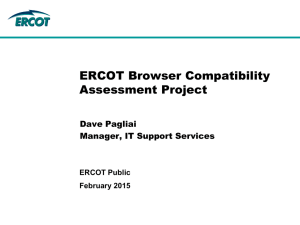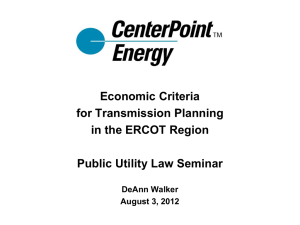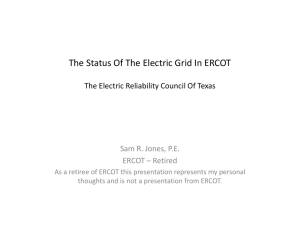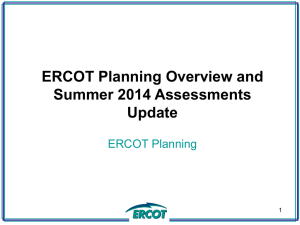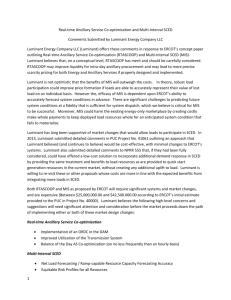06. Luminant Comments 100615 AS Methodology
advertisement
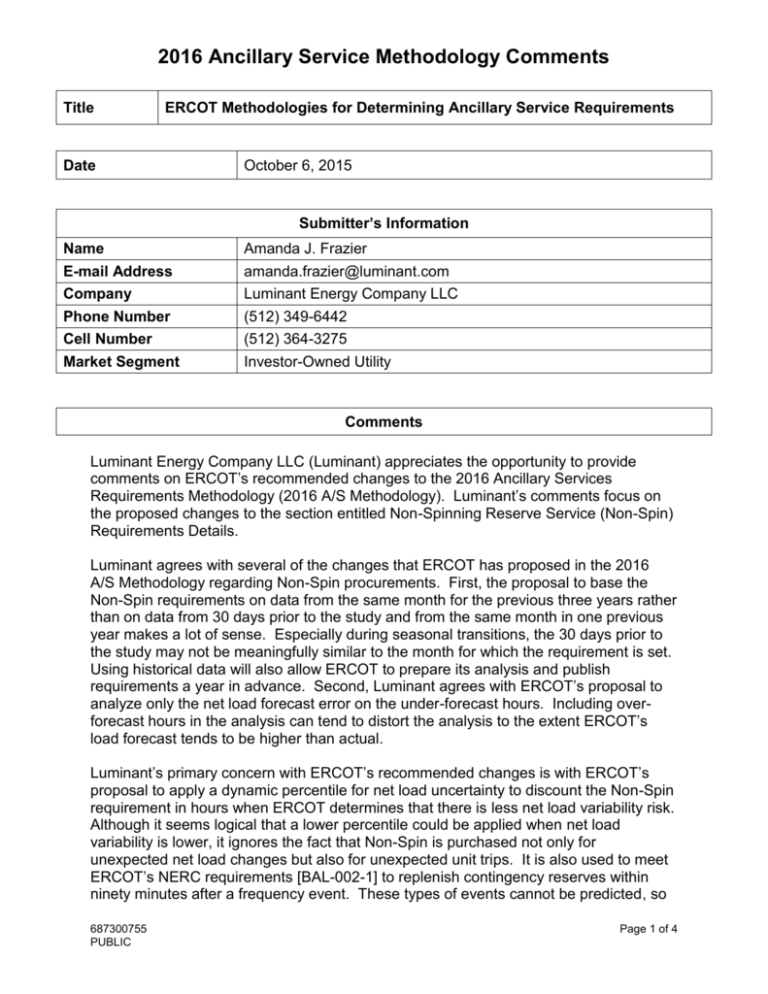
2016 Ancillary Service Methodology Comments Title ERCOT Methodologies for Determining Ancillary Service Requirements Date October 6, 2015 Submitter’s Information Name E-mail Address Company Amanda J. Frazier amanda.frazier@luminant.com Luminant Energy Company LLC Phone Number Cell Number Market Segment (512) 349-6442 (512) 364-3275 Investor-Owned Utility Comments Luminant Energy Company LLC (Luminant) appreciates the opportunity to provide comments on ERCOT’s recommended changes to the 2016 Ancillary Services Requirements Methodology (2016 A/S Methodology). Luminant’s comments focus on the proposed changes to the section entitled Non-Spinning Reserve Service (Non-Spin) Requirements Details. Luminant agrees with several of the changes that ERCOT has proposed in the 2016 A/S Methodology regarding Non-Spin procurements. First, the proposal to base the Non-Spin requirements on data from the same month for the previous three years rather than on data from 30 days prior to the study and from the same month in one previous year makes a lot of sense. Especially during seasonal transitions, the 30 days prior to the study may not be meaningfully similar to the month for which the requirement is set. Using historical data will also allow ERCOT to prepare its analysis and publish requirements a year in advance. Second, Luminant agrees with ERCOT’s proposal to analyze only the net load forecast error on the under-forecast hours. Including overforecast hours in the analysis can tend to distort the analysis to the extent ERCOT’s load forecast tends to be higher than actual. Luminant’s primary concern with ERCOT’s recommended changes is with ERCOT’s proposal to apply a dynamic percentile for net load uncertainty to discount the Non-Spin requirement in hours when ERCOT determines that there is less net load variability risk. Although it seems logical that a lower percentile could be applied when net load variability is lower, it ignores the fact that Non-Spin is purchased not only for unexpected net load changes but also for unexpected unit trips. It is also used to meet ERCOT’s NERC requirements [BAL-002-1] to replenish contingency reserves within ninety minutes after a frequency event. These types of events cannot be predicted, so 687300755 PUBLIC Page 1 of 4 2016 Ancillary Service Methodology Comments applying a lower percentile for Net Load uncertainty may cause ERCOT to underprocure Non-Spin when it is needed. ERCOT’s proposal is essentially saying that ERCOT is willing to take more risk during periods when the net load change from one hour to the next was low in the previous three years. This additional risk is proposed even though ERCOT has not shown why a 70th percentile coverage is more appropriate than a 95th percentile coverage especially when considering the randomness of unit outages. Luminant also questions ERCOT’s proposal to change its analysis from using a 6-hour ahead net load forecast error to a 3-hour ahead net load forecast error. One use for Non-Spin is a market tool for managing unexpected net load changes/errors. The other tool ERCOT has to manage the net load forecast error is the out-of-market Reliability Unit Commitment (RUC) process; however, this process is limited to selecting units whose start time will allow them to be on-line to cover a missed load forecast. Because the Non-Spin requirements are set in advance based on historical data, ERCOT should use the load forecast that best represents the point in time where, on average, ERCOT has sufficient capacity that can start in time to cover the average load forecast error at that same point in time. In 2015, ERCOT changed from using the midnight day-ahead forecast to using the 6-hour ahead forecast, because it was recognized that ERCOT likely has sufficient capacity with less than a 6-hour start time to cover the average load forecast error 6 hours out. ERCOT may also have sufficient capacity with a 3-hour start time to cover the average load forecast error 3 hours out, but Luminant asked for this data at QMWG and ERCOT has not yet provided it for review. Luminant believes that the 2016 A/S Methodology should not change which load forecast is used until ERCOT shows with empirical data that it makes sense to do. Using a 3-hour ahead load forecast rather than a 6-hour ahead load forecast will cause a reduction in the net load error calculation, which may result in ERCOT having less Non-Spin than it needs when those errors occur in Real-Time. Finally, Luminant would like to address the idea expressed in the stakeholder process that Non-Spin should be reduced or eliminated in order to increase ORDC adders. First, Ancillary Services requirements should be driven by reliability requirements, and ERCOT should not rely upon the over-supply of spinning capacity that may or may not be available when needed. Second, Luminant strongly disagrees that the purchase of Ancillary Services is causing excess On-Line capacity – any excess spinning capacity is most likely a result of over-hedging to protect against ORDC risk. Therefore, reducing Non-Spin requirements will not create a significant increase to the Real-Time ORDC adders, but will expose ERCOT to greater risk. The Non-Spin requirements need to be evaluated from a reliability perspective rather than a specific pricing outcome. Luminant looks forward to discussing these comments at the upcoming WMS, ROS, and TAC meetings. Revised Proposed Protocol Language 687300755 PUBLIC Page 2 of 4 2016 Ancillary Service Methodology Comments Non-Spinning Reserve Service (Non-Spin) Requirement Details Introduction Non-Spinning Reserve Service (Non-Spin) consists of Generation Resources capable of being ramped to a specified output level within 30 minutes or Load Resources that are capable of being interrupted within 30 minutes and that are capable of running (or being interrupted) at a specified output level for at least one hour. Non-Spin may be deployed to replace loss of generating capacity, to compensate for Load forecast and/or forecast uncertainty on days in which large amounts of reserve are not available online, to address the risk of net load ramp, or when there is a limited amount of capacity available for Security-Constrained Economic Dispatch (SCED). Historically, the need for Non-Spin has occurred during hot weather, during cold weather, during unexpected changes in weather or following large unit trips to replenish reserves. The periods when load is increasing and wind is decreasing requires other generation resources to increase output or come online quickly to compensate for the sudden net load increases. As a result, net load ramp risk should be accounted for in the determination of Non-Spin requirements. While net load analysis may cover reserves required for forecast uncertainty, it may not necessarily cover exposure to the loss of generation and net load ramp risk. Due to this risk, it may be necessary for ERCOT to have additional reserves available during high risk using a variable percentile to protect against forecast uncertainty. Examples of circumstances when Non-Spin has been used are: Across peak hours during spring and fall months when hotter than expected weather with large amounts of capacity offline resulted in Energy Emergency Alert (EEA) events; Afternoons during summer seasons when high loads and unit outages outstripped the capability of base load and normal cyclic units; Cold weather events when early morning load pickup outpaced the ability of generation to follow; Major unit trips when large amounts of spinning reserve were not online; and During periods when the wind decreased and load demand increased. Summary Analysis for Non-Spin requirements are conducted using data from the same month of previous three years. For the purpose of determining the amount of Non-Spin to purchase for each hour of the day, hours will be placed into four hour blocks. The Non-Spin requirement for the month for each block is calculated using the 95th percentile of net load uncertainty for each block minus the average Reg-Up requirement during the same block of hours. 687300755 PUBLIC Page 3 of 4 2016 Ancillary Service Methodology Comments After this analysis has been completed, ERCOT will apply a floor on the final Non-Spin requirement equal to the largest unit. This floor will only be applied to On-Peak Hours, which are hour ending 7 through 22. ERCOT will post the monthly amounts for Non-Spin requirements for the upcoming year on the MIS. Procedure ERCOT will determine the Non-Spinning reserve requirement using the 95th percentile of hourly net load uncertainty from the same month of the previous three years. Net load is defined as the ERCOT load minus the estimated un-curtailed total output from Wind-powered Generation Resources (WGRs) at a point in time. The forecast of net load is computed by subtracting the aggregate WGR High Sustained Limits (HSLs) in the Current Operating Plans (COPs) from the Mid-Term Load Forecast (MTLF). The COPs and MTLF used are the updated values as of six hours prior to each Operating Hour. The net load uncertainty is then defined as the difference between the net load and the forecasted net load. ERCOT will purchase Non-Spin such that the combination of Non-Spin and Reg-Up Services cover the uncertainties of net load forecast errors. For On-Peak Hours (hours ending 7 through 22), ERCOT will also set a floor on the Non-Spin requirement equal to the capacity of the single largest contingency. 687300755 PUBLIC Page 4 of 4
